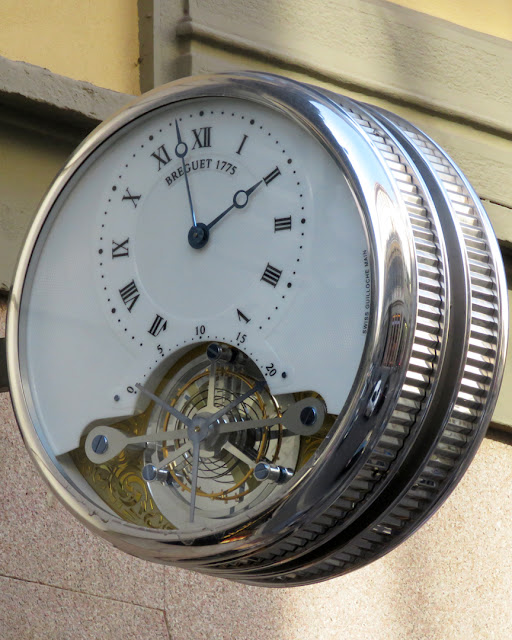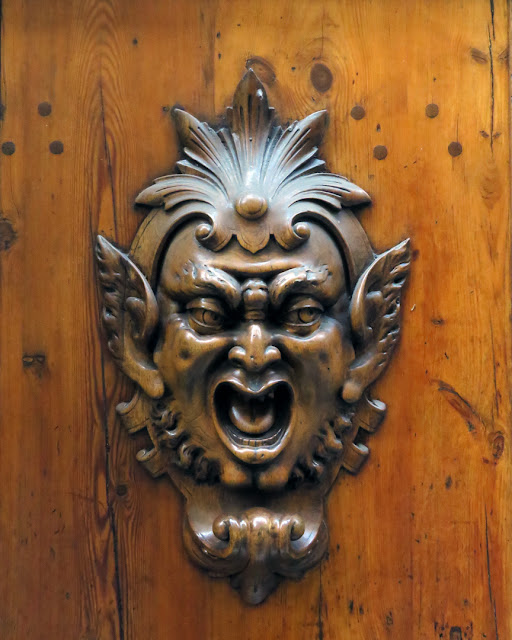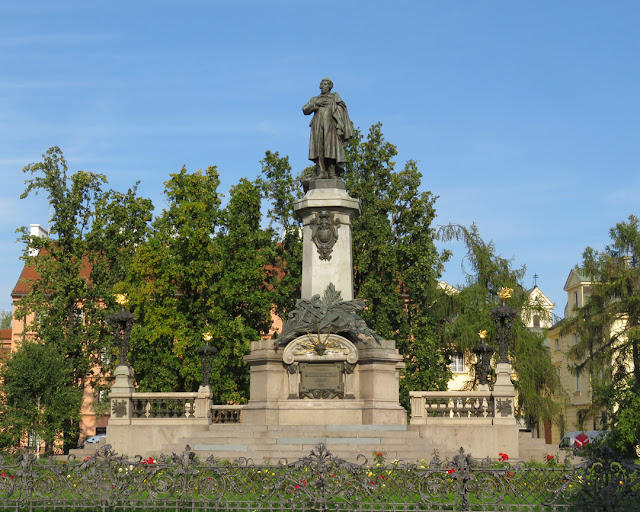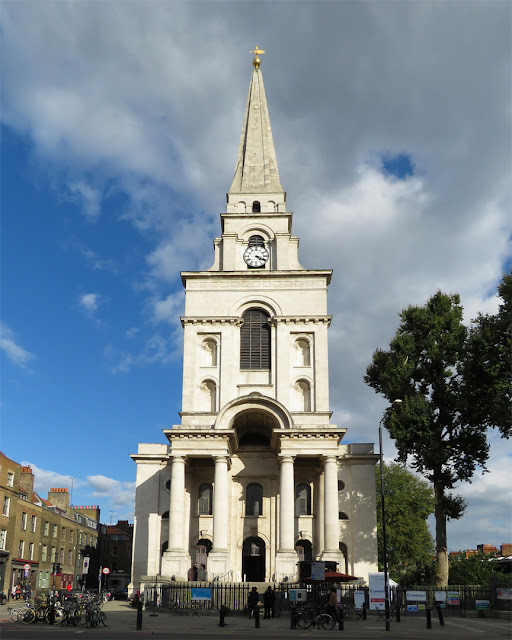Wednesday, October 31, 2018
Zamek Królewski
Zamek Królewski (Royal Castle)
Plac Zamkowy
Warsaw, September 2018
“The Royal Castle in Warsaw (Zamek Królewski w Warszawie) is a castle residencythat formerly served throughout the centuries as the official residence of the Polish monarchs. It is located in the Castle Square, at the entrance to the Warsaw Old Town. The personal offices of the king and the administrative offices of the Royal Court of Poland were located there from the sixteenth century until the Partitions of Poland." (Royal Castle, Wikipedia)
Tuesday, October 30, 2018
St George Wharf Tower
St George Wharf Tower by Broadway Malyan, 2014
St George Wharf
Vauxhall, Lambeth
London, September 2015
“St George Wharf Tower, also known as the Vauxhall Tower, is a residential skyscraper in Vauxhall, London, and part of the St George Wharf development. At 181 metres (594 ft) tall with 50 storeys, it is the eighth-tallest building in London and the tallest residential building in the United Kingdom. Whilst under construction, in 2013 a helicopter collided with a crane on the building and crashed to the ground, causing two deaths. The tower's floor-plan design is based on the shape of a Catherine wheel and is typically divided into five apartments per floor with separating walls radiating out from the central core. Sky gardens provide residents with a semi-external space stepped forward from the pure circular plan, creating steps in the façade that accentuate the building's height and provide variety and interest in the detailing of the otherwise minimal cladding. The building is divided into three distinct parts—a base that houses the communal facilities of the building including a lobby, business lounge, gym, spa and swimming pool; a middle section containing most of the apartments; and an upper section where the façade reduces in diameter to provide 360-degree terraces and a wind turbine that tops the structure. The wind turbine, manufactured by British green-technology company Matilda's Planet, powers the tower's common lighting, whilst creating virtually no noise or vibration. At the base of the tower, water is drawn from the London Aquifer and heat-pump technology is used to remove warmth from the water in the winter to heat the apartments. In comparison to similar buildings, the tower requires one third of the energy, and produces between one half and two thirds of typical carbon dioxide emissions. It is triple-glazed to minimise heat loss in winter and heat gain in summer, with low-e glazing and ventilated blinds between the glazing to further reduce heat gain from direct sunlight. Special stairs for the luxury lower penthouse apartments are supplied. These apartments and stairs are a mirror of each other. In one of these apartments there is a 360-degree view across London. The highest swimming pool in the city is located in this apartment.” (St George Wharf Tower, Wikipedia)
Monday, October 29, 2018
Vedovella
Vedovella (Little Widow) drinking fountain
Piazza della Scala
Milan, November 2016
“In the municipality of Milan there are over 400 small drinking fountains originally installed in public gathering places such as flower and vegetable markets, public parks, churches and cemeteries. The cast iron fountains were cast by Fonderia Lamperti at the end of the 19th century from a design by Sir Richard Wallace, a wealthy English art collector and philanthropist who lived in France. The constant flow of water prevents the formation of bacteria. Run off water is channelled to the municipal water purifier and used in the cultivated fields surrounding the city. The fountains are maintained by Metropolitana Milanese to ensure the quality of the water. This company created a map identifying the location of all 418 small fountains with the hope that it would encourage their use and reduce the use of plastic water bottles. These drinking fountains are known as Vedovelle (Little Widows) in reference to the constant stream of water which resembles the tears of grieving widows.” (Vedovelle Fountains, Memorial Drinking Fountains)
Sunday, October 28, 2018
Kościół ŚŚ Piotra i Pawła
Kościół ŚŚ Piotra i Pawła
Church of Saints Peter and Paul
ulica Grodzka
Stare Miasto (Old Town)
Kraków, September 2018
“In front of the church-grounds there are several plinths with raised sculptures of apostles designed by Kacper Bażanka. They were made with Pińczów limestone, and completed in 1722 by Dawid Heel. Today, in place of the original 18th century statues, which were very much damaged by acid rain, there are contemporary copies made of the same material by Kazimierz Jęczmyk.” (Saints Peter and Paul Church, Wikipedia)
Saturday, October 27, 2018
Rue Dunkerque
Gare du Nord (North Station)
Rue Dunkerque
Quartier Saint-Vincent-de-Paul, 10th arrondissement
Paris, July 2005
“Like other Parisian railway stations, the Gare du Nord rapidly proved to be too small to handle persistence increases in railway traffic. Accordingly, the station has been periodically reconfigured. During 1884, engineers were able to install five supplementary tracks. During 1889, the station's interior was completely rebuilt, while an extension was constructed along its eastern side to serve the suburban rail lines. Further rounds of expansion work were carried out between the 1930s and the 1960s.” (Gare du Nord, Wikipedia)
Friday, October 26, 2018
Umberto Gregori dentista
“Umberto Gregori dentista” (Umberto Gregori dentist)
Marble sign by Guido Bianconi, 1914
Via di Città
Siena, April 2017
Thursday, October 25, 2018
The Alphabet
Keith Haring. The Alphabet
Staircase of the Albertina Museum
Albertinaplatz
Vienna, June 2018
“The Albertina Museum is devoting a sweeping exhibition to Keith Haring (1958–1990), who would have celebrated his 60th birthday in 2018. This presentation is intended to shed light on the output of this exceptional American artist from perspectives both art-historical and formal. A special focus will be on the one-of-a-kind symbolic language that is present throughout Haring’s oeuvre as an artistic alphabet of sorts. The artist’s subway works and other drawings, as well as his paintings and sculptures, are devoted to themes of social justice and constant transformation. The appeal of Haring’s oeuvre remains unbroken to this day, and his influence on his contemporaries and younger generations of artists has been enormous.” (Keith Haring. The Alphabet, Albertina)
Wednesday, October 24, 2018
Aurora
Aurora animatronic polar bear by Greenpeace
Shell Centre
Belvedere Road
South Bank
London, September 2015
“Greenpeace campaigners, including actress Emma Thompson, installed a animatronic polar bear the size of a double-decker bus outside Shell’s London headquarters to demonstrate against the company’s drilling in the Arctic on Wednesday. The sixty-odd activists, six of who are attached to the three-tonne bear named Aurora, moved into place at around 4am this morning. The bear will ‘roar’ throughout the morning. Greenpeace is demanding Shell halt drilling in Arctic, which the environmental group says is placing the area at extreme risk of an oil spill. Researchers claim the company's drilling is incompatible with limiting global warming to no more than two degrees above pre-industrial levels.” (Greenpeace activists install giant polar bear outside Shell's London headquarters, Independent)
Tuesday, October 23, 2018
Allegory of Africa
Allegory of Africa by Eleuterio Pagliano
Replaced in 1921 with a mosaic by Alessandro Dal Prato
Galleria Vittorio Emanuele II
Piazza del Duomo
Milan, November 2016
Monday, October 22, 2018
Polska Filharmonia Bałtycka
Polska Filharmonia Bałtycka
Polish Baltic Philharmonic
Ołowianka
Gdańsk, September 2018
“The building, which houses the Baltic Philharmonic Hall today was constructed in 1897-1898 as a power station with a neo-Gothic façade. The seat of the Polish Baltic Philharmonic is a complex of buildings at the former plant of the late nineteenth century, located on the island of Ołowianka in Gdańsk. After the plant was closed in 1996, it was subsequently adapted between 1996-2005 as a concert hall. This urban power station was built between 1897-1898 by the Berlin firm of Siemens & Halske, with further expansion continuing through 1913. This brick building with its elegant neo-Gothic façade is decorated with rosettes, turrets and even two tower. During the final months of World War II, the complex suffered severe damage. Launched back in August 1945 the power plant operated until its closure in 1996. The reconstruction, development and adaptation of these buildings was done by the architectural studio of Martin Kozikowski and KD Kozikowski Design.” (Wikipedia)
Sunday, October 21, 2018
Cheminots de la région du Nord
Memorials to railway workers fallen in war (1914-18) (1939-45)
Gare du Nord, Rue de Maubeuge
Quartier Saint-Vincent-de-Paul, 10th arrondissement
Paris, July 2005
Saturday, October 20, 2018
Accademia degli Intronati
Accademia degli Intronati
Via di Città
Siena, April 2017
“The Accademia degli Intronati was the center of intellectual life in Siena around the 1550s.[1] It was founded between 1525 and 1527 as a gathering place for aristocracy. The first publicly hosted event was the comic play Gl'ingannati, written collectively by the Intronatis. A characteristic of the Academy was its preference for comedy and the targeting of a female public. This distinguished the plays of the Academy's first wave of productions.” (Accademia degli Intronati, Wikipedia)
Thursday, October 18, 2018
Susanna Wesley
Birthplace of Susanna Wesley (née Annesley)
Spital Yard
Spitalfields
London, September 2015
“Susanna Wesley (née Annesley; 20 January 1669 – 23 July 1742) was the daughter of Dr Samuel Annesley and Mary White, and the mother of John and Charles Wesley. Susanna Wesley, was the 25th of 25 children. Her father, Dr Samuel Annesley, was a Dissenter from the established church in England. At the age of 12, Susanna stopped attending her father's church and joined the Church of England. She and Samuel Wesley were married on 11 November 1688; Samuel was 26 and Susanna was 19. Susanna and Samuel Wesley had 19 children. Nine of her children died as infants. Four of the children who died were twins. A maid accidentally smothered one child. At her death, only eight of her children were still alive.” (Susanna Wesley, Wikipedia)
Wednesday, October 17, 2018
Tuesday, October 16, 2018
Juliusz Słowacki Theatre
Juliusz Słowacki Theatre, 1893
plac Świętego Ducha
Stare Miasto (Old Town)
Kraków, September 2018
“Juliusz Słowacki Theatre in Kraków, Poland, (Polish: Teatr im. Juliusza Słowackiego w Krakowie), erected in 1893, was modeled after some of the best European Baroque theatres such as the Paris Opera designed by Charles Garnier, and named after Polish poet Juliusz Słowacki in 1909.” (Juliusz Słowacki Theatre, Wikipedia)
Monday, October 15, 2018
Isidore Taylor
Monument to baron Isidore Taylor by Tony Noël, 1907
Place Johann-Strauss
Quartier de la Porte-Saint-Martin, 10th arrondissement
Paris, July 2008
“Isidore Justin Séverin Taylor was born in Brussels on 5 August 1789 and died in Paris on 6 September 1879. He was closely associated with the development of French theatre, a noted traveller and author, and a philanthropist.” (Baron Isidore Justin Séverin Taylor, Wikipedia)
Sunday, October 14, 2018
Saturday, October 13, 2018
Gänsemädchenbrunnen
Goose girl fountain (Gänsemädchenbrunnen) by Antonín Pavel Wagner, 1866
Rahlstiege (Rahl Steps)
Mariahilfer Strasse
Vienna, June 2018
“The geese girl fountain (Gänsemädchenbrunnen) created by the Czech sculptor Antonín Pavel Wagner shows a girl with three geese. The geese refer to the first site of the fountain which was the former poultry market of the city. Today you can find this fountain next to the Rahlstiege, a staircase in the 6th district of Vienna.” (Geese girl fountain in Vienna, Travelwriticus)
Friday, October 12, 2018
The Arch 1979–1980
The Arch 1979–1980 by Henry Moore
Kensington Gardens
London, September 2015
“The Arch 1979–1980 is a large stone sculpture by Henry Moore located in Kensington Gardens, London. It was given to the park by Moore in 1980. ‘After the 1978 exhibition at the Serpentine Gallery in London, in which several large pieces were located in Kensington Gardens, there was a request for me to leave a sculpture there permanently, which I agreed to do. I thought the Large Arch was very naturally sited, particularly as it could be seen reflected in the water from across the lake. During the exhibition, many people believed the sculpture to be made of marble, but in fact it was a fibreglass exhibition cast made originally for my exhibition at the Forte di Belvedere in Florence (1963), because of the difficulty of getting a very heavy bronze or marble on to the site. Therefore, so that it could be left as a permanent sculpture in Kensington Gardens, I produced a version in travertine marble which is a very lasting material.’ The Arch was found to be unstable in 1996, and was subsequently dismantled and placed into storage. It was restored and replaced in its original location in 2012.” (The Arch 1979–1980, Wikipedia)
Adam Mickiewicz Monument
Adam Mickiewicz Monument by Cyprian Godebski, 1898
Krakowskie Przedmieście
Warsaw, September 2018
“Writer Henryk Sienkiewicz helped to raise awareness among the Warsaw intelligentsia, and by his effort, the Russian authorities permitted the construction of the monument. A public committee was founded by Sienkiewicz, Count Michał Radziwiłł and Zygmunt Wasilewski. The committee asked people for financial contributions to help build the monument. The financial support was quickly raised and the work was assigned to sculptor Cyprian Godebski. The monument was built on a place where several buildings, demolished in 1865, were located. From 1897 it was sculpted by Godebski in Italy. The 4.2 m tall bronze statue was cast in Pistoia, Italy. Red granite column and foundations were produced by an Italian company in Baveno near Milano. The statue shows Mickiewicz standing tall, with his head slightly raised and his right hand laid upon his heart. The monument was ceremonially unveiled on 24 December 1898 on the 100th anniversary of poet's birth. The ceremony was planned to be much larger, however the Tsarist authorities feared it could turn into a patriotic manifestation and banned all marches and speeches. The monument was thus unveiled in silence, in front of 12,000 people. After the end of the Warsaw Uprising in 1944 it was deliberately destroyed by Nazi Germans. Remaining parts of the demolished monument were eventually transported to Germany. After the war, Polish soldiers found the head and several parts of the statue in Hamburg. Sculptor Jan Szczepkowski produced the copy of the original statue. The environs around the monument were also restored. It was unveiled again on 28 January 1950. The last parts of the monument were returned to Poland as late as the 1980s.” (Adam Mickiewicz Monument, Wikipedia)
Thursday, October 11, 2018
Nei secoli fedele
“Nei secoli fedele” (Loyal throughout the centuries)
Cake dedicated to the Arma dei Carabinieri
Pasticceria Cova
Via Monte Napoleone
Milan, May 2016
Wednesday, October 10, 2018
SS Sołdek
SS Sołdek
Part of National Maritime Museum
ulica Ołowianka
Gdańsk, September 2018
“SS Sołdek was a Polish coal and ore freighter. She was the first ship built in Szczecin (Poland) after World War II and the first seagoing ship completed in Poland. She was the first of 29 ships classed as Project B30, built between 1949 and 1954 in Stocznia Gdańska (Gdańsk Shipyard). The name was given in honour of Stanisław Sołdek, one of the shipyard's shock workers. The ship is currently preserved as a museum ship in Gdańsk, as a part of National Maritime Museum collection.” (SS Sołdek, Wikipedia)
Tuesday, October 9, 2018
Gare du Nord
Gare du Nord (North Station)
Place Napoléon-III
Quartier Saint-Vincent-de-Paul, 10th arrondissement
Paris, July 2005
“The Gare du Nord (North station), officially Paris-Nord, is one of the six large mainline railway station termini in Paris, France. The station accommodates trains between the capital and Northern France via the Paris–Lille railway, as well as to international destinations in Belgium, Germany, the Netherlands and the United Kingdom. Located in the northern part of Paris near the Gare de l'Est in the 10th arrondissement, the Gare du Nord offers connections with several urban transport lines, including Paris Métro, RER and buses. It is the busiest railway station in Europe by total passenger numbers; in 2015, the Gare du Nord saw an excess of 700,000 passengers per day. The current Gare du Nord was designed by French architect Jacques Ignace Hittorff, while the original complex was constructed between 1861 and 1864 on behalf of the Chemin de Fer du Nord company. The station replaced an earlier and much smaller terminal sharing the same name, which had been operational between 1846 and 1860. The majority of its passengers have been commuters travelling between the northern suburbs of Paris and outlying towns. A substantial refurbishment programme being performed during the late 2010s and early 2020s shall greatly redesign the Gare du Nord. This shall involve a significant expansion of the station's footprint and ability to handle passengers, expanding onsite amenities and establishing a new departure terminal in preparation for the 2024 Summer Olympics. As a consequence of this redevelopment, the Gare du Nord will become the largest railway station in Europe.” (Gare du Nord, Wikipedia)
Monday, October 8, 2018
Sant'Agostino
Church of Sant'Agostino
Prato di Sant'Agostino
Siena, April 2017
“The construction of the church and its associated convent began in 1258 and lasted for more than fifty years. Other renovations and reconstructions were carried out in the following centuries. The church had a major fire in 1747. A few years after this fire, the interior was redesigned by Luigi Vanvitelli, and he maintained the large altars in polychrome marble from the 16th and 17th centuries. The stucco statues in the nave and in the transept date from the Vanvitelli renovation. The portico was constructed in the early 19th century by Agostino Fantastici. ” (Sant'Agostino, Wikipedia)
Sunday, October 7, 2018
Hotel Bristol
Hotel Bristol
Krakowskie Przedmieście
Warsaw, September 2018
“The Hotel Bristol was constructed from 1899-1900 on the site of the Tarnowski Palace by a company whose partners included Polish pianist Ignacy Jan Paderewski. A competition was held for the design of the building, and architects Thaddeus Stryjeriski and Franciszek Mączyński won with their Art Nouveau design. However the builders decided to change the style to a Neo-Renaissance design, and brought in architect Władysław Marconi to design the final hotel. Some of its interiors were designed by the noted Viennese architect Otto Wagner Jr. The cornerstone was laid on April 22, 1899 and the hotel was dedicated on November 17, 1901 and opened on November 19, 1901. After Poland gained its independence in 1919, Paderewski became the Prime Minister and held the first session of his government at his hotel. Paderewski and his partners sold their shares in the hotel in 1928 to a local bank, which renovated the hotel in 1934 with modern interiors by designer Antoni Jawornicki. Upon the German invasion in 1939, the hotel was made into the headquarters of the Chief of the Warsaw District. It miraculously survived the war relatively unscathed, standing nearly alone among the rubble of its neighborhood. Following the war, the hotel was renovated and reopened in 1945. The City of Warsaw took over operation of the hotel in 1947 and it was nationalized in 1948 and joined the state-run Orbis chain in 1952, exclusively serving visitors from abroad. By the 1970s its outdated facilities had seen it demoted to a second class ranking by the government and the hotel was donated by Prime Minister Piotr Jaroszewicz to the University of Warsaw in 1977 to eventually serve as their library. It closed in 1981.” (Hotel Bristol, Wikipedia)
Saturday, October 6, 2018
Christ Church
Christ Church by Nicholas Hawksmoor, 1729
Commercial Street
Spitalfields
London, September 2015
“Christ Church Spitalfields is an Anglican church built between 1714 and 1729 to a design by Nicholas Hawksmoor. On Commercial Street in the East End and in today's Central London it is in the London Borough of Tower Hamlets, on its western border facing the City of London, it was one of the first (and arguably one of the finest) of the so-called "Commissioners' Churches" built for the Commission for Building Fifty New Churches, which had been established by an Act of Parliament in 1711. The purpose of the Commission was to acquire sites and build fifty new churches to serve London's new settlements. This parish was carved out of the circa 1 square mile (2.6 km2) medieval Stepney parish for an area then dominated by Huguenots (French Protestants and other 'dissenters' who owed no allegiance to the Church of England and thus to the King) as a show of Anglican authority. Some Huguenots used it for baptisms, marriages and burials but not for everyday worship, preferring their own chapels (their chapels were severely plain compared with the bombastic English Baroque style of Christ Church) though increasingly they assimilated into English life and Anglican worship – which was in the eighteenth century relatively plain. The Commissioners for the new churches including Christopher Wren, Thomas Archer and John Vanbrugh appointed two surveyors, one of whom was Nicholas Hawksmoor. Only twelve of the planned fifty churches were built, of which six were designed by Hawksmoor.” (Christ Church, Wikipedia)
Friday, October 5, 2018
Thursday, October 4, 2018
Eros Bendato
Eros Bendato (Eros Bound) by Igor Mitoraj, 1999
Rynek Główny
Stare Miasto (Old Town)
Kraków, September 2018
“Among Kraków’s most well-known landmarks, this sculpture in the western corner of the market square is a popular meeting place and at some point serves as a photographic backdrop for almost every tourist who visits the city. Affectionately referred to as ‘The Head’, the bronze body part’s official title is ‘Eros Bendato’ (Eros Bound) and is the work of Polish artist Igor Mitoraj (1944 - 2014). A student of Tadeusz Kantor at the Kraków School of Art, an exhibition of 14 of Mitoraj’s monumental works dressed the Rynek from Oct 17, 2003 to Jan 25, 2004, during which the artist gifted this work to the city, sparking controversy over what to do with it. Initially, the sculpture was designated for the square in front of Galeria Krakowska, but the artist was indignant about having his work in front of a commercial building. Despite protest from historians and many locals, the sculpture eventually found its current place near the Town Hall Tower, where it has become an unexpected tourist attraction.” (Eros Bendato, In Your Pocket)
Wednesday, October 3, 2018
Église Saint-Séverin
Église Saint-Séverin (Church of Saint-Séverin)
Rue des Prêtres Saint-Séverin
Quartier de la Sorbonne, 5th arrondissement
Paris, July 2014
“The Church of Saint-Séverin (Église Saint-Séverin) is a Roman Catholic church in the Latin Quarter of Paris, located on the lively tourist street Rue Saint-Séverin. It is one of the oldest churches that remains standing on the Left Bank, and it continues in use as a place of worship.” (Saint-Séverin, Wikipedia)
Tuesday, October 2, 2018
Torre del Mangia
Torre del Mangia, 1348
Piazza del Campo
Siena, April 2017
“The Torre del Mangia is a tower in Siena, in the Tuscany region of Italy. Built in 1338-1348, it is located in the Piazza del Campo, Siena's premier square, adjacent to the Palazzo Pubblico (Town Hall). When built it was one of the tallest secular towers in medieval Italy. At 102 m, it is second tallest after Cremona's Torrazzo (112 m (367 ft)), the Asinelli tower in Bologna at 97 m being third. The tower was built to be exactly the same height as the Siena Cathedral as a sign that the church and the state had equal amounts of power. Literally meaning ‘Tower of the Eater’, the name refers to its first bellringer, Giovanni di Balduccio, nicknamed Mangiaguadagni (‘Eat-the-profits’, that is ‘Profit eater’) either for his spendthrift tendency, idleness or gluttony.” (Torre del Mangia, Wikipedia)
Monday, October 1, 2018
John of Matha
Statues of John of Matha, Felix of Valois and Saint Ivan by Ferdinand Brokoff, 1714
Karlův most (Charles Bridge)
Prague, September 2017
Subscribe to:
Posts (Atom)































